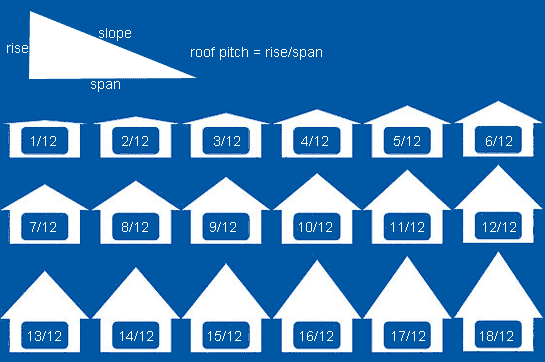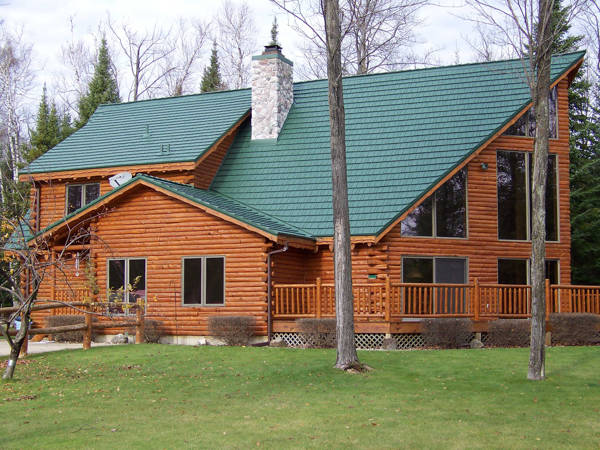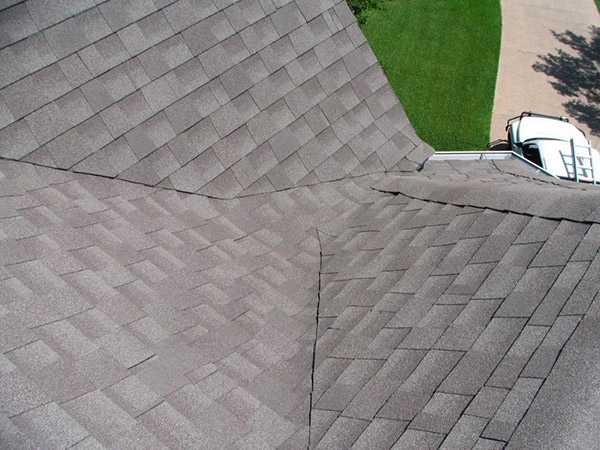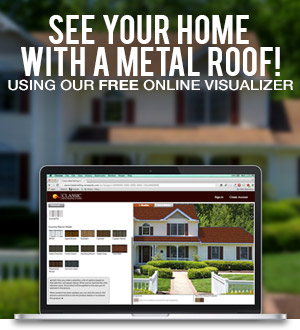Roof Geometry: How Does the Shape of Your Roof Impact Your Roofing Decisions?
July 5, 2017 | Filed under: Miscellanous Articles,Research
Here’s something you might not have considered that affects roof performance: roof geometry. How does the shape of your roof impact your roofing decisions? As you read, we encourage you to refer to our online Glossary of Roofing Terms.
ROOF PITCH

The pitch, or steepness, of a roof is often referred to in terms of the amount of vertical rise over a 12” horizontal run. For example, a 5:12 pitch roof will rise vertically 5” for every 12” it goes back horizontally. There are smartphone apps available which can be used to “sight” a roof’s pitch from the ground. The pitch of a roof plays a role in determining what roofing materials are appropriate, what sort of ventilation options exist, and the cost of labor to repair or replace the roof. Additionally, roof pitch can impact the positioning of gutters at the bottom edge of the roof, so that water is properly collected and carried away.
Low Pitch
Any roofs up to 3:12 are generally considered “low slope.” In the residential arena, we see lower slope roofs as part of the home’s architectural design. We also sometimes see low slope roofs on just certain areas of a home such as porches. Another common area for these roofs is on manufactured homes. When it comes to metal, only mechanically seamed standing seam roofs should be used on pitches lower than 2:12. With this style of metal roof, the seams between the panels are actually crimped shut to be watertight. For roofs of 2:12 or greater pitch, products like our ClickLock standing seam work very well. Then, when you get into roofs of 3:12 or greater pitch, most other metal roofs can be used and that generally is the pitch requirement for asphalt shingles as well.Walkable Pitch
Of course, when it comes to the pitch, or steepness, of your roof, one person’s idea of “walkable” may be another person’s idea of “there’s no way I am getting up there!” And, generally, we encourage folks to do things to their roofs and anything on their roof (dormers, chimneys, skylights, pipes, etc.) that will never require them to climb up there! But, as a general rule, contractors will approach working on roofs greater than 6:12 pitch a little different than lower slope roofs, and their approach goes to a different level at 8:12 as well. As the roofs get steeper, additional safety equipment may be needed and additional time is required for roof work. This all affects cost. One benefit of metal roofing is that it maintains its walkability even as it ages. For walkable roofs, many of the more heavily profiled metal roofs such as shake and shingle profiles, will have optional strengthening foam backers to assist walking on the roof. These can be used on the entire roof or just in traffic areas such as around chimneys, dormers, etc.High Pitch
We often seen metal roofs, and other more decorative roofs, being used on homes with steeply pitched roofs. On these homes, the aesthetics of the roof play a big role. The roof becomes such a significant part of the home’s visual exterior that property owners seek out roofing products that have extra design features and beauty. Another thing to keep in mind on high pitch roofs is that labor for roof work can be very costly. With a shortage of skilled trades, that cost is going up rapidly. So, a durable roof that will end the need for future repair or replacement can be a very wise choice and a good way for property owners to protect themselves from exorbitant roof costs in the future.Multi-Pitch
Some homes are designed with multiple roof pitches. This may include transitions on the roof from one pitch to another or it can involve varying roof pitches meeting at valleys or hips on the roof. These all can be tricky areas, necessitating forethought and skill on the part of the roofing technicians. For example, it can dramatically impact hip treatment when the courses of shingles adjoining at the hips do not “match up” due to the varying pitches. If your home has multiple roof pitches, be certain to discuss with your contractor exactly how those areas will be handled.
ROOF DESIGN
The design of a roof is driven by the home’s architectural style. While many residential roofs are “Plain Vanilla” straight gable roofs with little complexity, others are Rocky Road with sprinkles and pistachio nuts on top – complicated rooflines that, while visually appealing, can really impact the dynamics of roof repair and replacement. Do any of the following sound like your roof?
Hip Roofs
When you think of a roof that just has a front and a back, that is usually a gable roof. However, a four-sided roof is usually a hip roof. One major factor to consider on a hip roof is that there is often very little peak or ridge area at the top of the roof. As a result, getting enough exhaust ventilation on the roof can be a challenge. Additionally, accessing a steeply pitched hip roof can be very time consuming for roofing contractors.
Mansard Roofs
Common on French-style architecture as well as some mid-century modern homes, mansard roofs are steeply pitched roofs often covering the walls of the upper story of the home. Sometimes they conceal a flat or very low slope roof on top of the structure (which may have special needs of its own). The biggest concern with mansard roofs is that their near-vertical pitches can cause many roofing materials to slip out of place as they age. For that reason, an interlocking metal roofing system can be a great choice on mansard roofs. Another frequent concern on mansard roofs is windows that either are inset into the mansard or protrude from it. These windows will require careful flashing.
A-Frame Roofs
A-Frame roofs have the same issue as mansard roofs in that many roofing materials want to slip out of place on the near vertical surfaces. They also often have doors and windows as part of the roof surface. An additional challenge of A-Frames though is that, being at ground level, they are more subject to damage over time. This can occur from mowers, things leaned against the house, etc. For that reason, an A-Frame roof really benefits from a strong, durable roof that is not easily damaged.
Bell-Shaped Roofs
Bell-Shaped roofs can have convex curves, concave curves, or both! We see these roofs frequently on French Provincial and Acadian home designs. Accomplishing the curves can be very difficult for vertical seam metal roofs but is usually easily accomplished with horizontally-run metal shingle roofs. One concern with roofs of this design is that sometimes the roof can go very low pitch either at the bottom or the top of the bell curve. That can impact what sort of roofing material is appropriate. Sometimes the roof pitch can be increased and sometimes two different roofing materials can be used for an accent and to accommodate the low pitch area.
Round Roofs
Over the years, we have seen a few homes that had truly round or oval areas either as the entire roof or on a turret or tower. In some cases, though, the appearance of a curve is accomplished through a roof that is made of several segments. The segmented roofs are easier to roof than true round roofs. Round roofs can be accomplished, however, with tapered standing seam metal panels or with certain metal shingles that can be custom-curved and arched.
Geodesic Domes
If you’re the lucky owner of a geodesic dome, you know that roofing is not something you want to have to tackle on a regular basis. It is difficult and expensive. And yet the comfort and security of your home depend upon a good roof. While for many years we shied away from geodesic domes, we have seen several skilled metal roofing contractors develop great ways to cover domes with beautiful metal shingles. Contact us right away if you have a dome home that is in need of some roofing care. It’s pretty complicated to explain here but metal roofs offer great dome solutions!
Gambrel Roofs
Often described as “barn roofs,” Gambrel Roofs are distinctively beautiful. They combine some of the factors of Mansard and A-Frame roofs with transitions of roof pitch. It is not unusual on these roofs to hear of problems at the pitch transitions. The benefit of metal roofing is that it easily accommodates a transition flashing that goes under the higher level roof and comes out on top of the lower roof. Slate look metal panels can be very attractive on these roofs.
ROOF FEATURES
Even with over 35 years of roofing industry experience, we are always running into “new things” on roofs that require some real planning and ingenuity. Please call us at 1-800-543-8938 if you have anything on your roof that is making you scratch your head. Below are three things that you might already be thinking about.
Valleys
If your roof has intersecting planes that result in valleys, we encourage you to talk to your contractor about how these areas will be handled. If your roof might get tree leaves, pine needles, ice, or snow on it, the valley treatment must allow for that debris to flow off the roof and not be trapped or cause water blockages. Additionally, valleys are areas of great wear on a roof due to a high volume of rushing water running down them. Metal valley pans can accommodate this activity very well with years of maintenance-free protection.
Flared Gables
Flared Gables occur when the ridge (peak) of a roof is wider than the eave (bottom) of the roof. Especially common on log homes, these are similar to valleys in that everything uphill of the flared gable will run into it. Special flared gable treatments are necessary which will not trap tree leaves, snow, etc. Most standard gable trims for metal roofs will not work on flared gables.
Dead Valleys
If your roof has a Dead Valley, you probably know it all too well because these are frequent problem areas. Dead valleys occur when two roof sections adjoin at their downhill edges. The result is usually a low slope roof area where a great deal of water must flow. In some cases, these can be addressed with large metal pans. In other cases with metal roofs, they are handled with various membranes or other roofing materials. If a non-metal roofing material is used in conjunction with a metal roof, make sure that there is a plan in place which will allow for the non-metal product to be replaced before the metal roof needs to be addressed.
If your roof has has an area that is of concern to you, just drop a note to Todd Miller, our president and in-house roofing guru. He responds quickly and thoroughly to emails and can be reached at . Send a description of your roof situation and, if possible, include photos.



